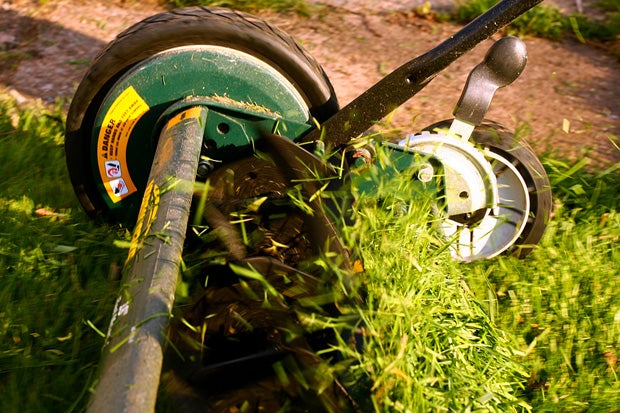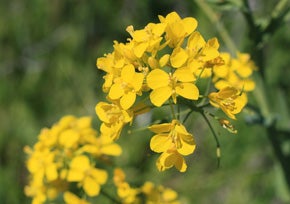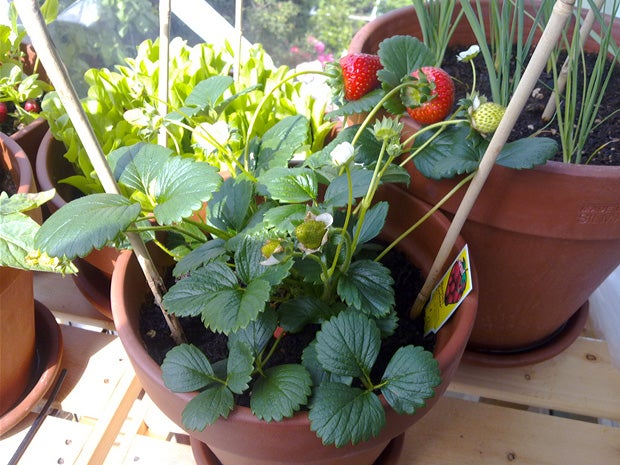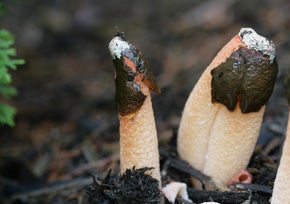Grass clippings could be contaminating your compost
ListenMike McGrath explains how to make homemade mustard, what you can do for your storm-damaged trees, how to grow strawberries from seed, what stink horn fungus is, how to plant new bushes, and why grass clippings do not belong in your compost pile.
Questions of the Week:
My father-in-law bags his lawn clippings for the first few mows of the season and doesn’t switch over to his mulching mower until the weather warms up, around the beginning of June. He says that the clippings don’t decompose in cool weather, and will build up thatch. I, on the other hand, set my mower to mulch right away. So: does time of year and/or temperature matter for using a mulching mower? Both of us have compost bins for leaves and other yard waste, so any clippings we do bag won’t go out to the curb. Thanks,
— Mike from Ashburn, VA
Should we put our grass clippings into our compost pile? Thanks,
— Betsy in Falls Church, VA
Every year I use about seven cubic yards of municipal compost to help make my clay soil more productive. However, this year I am worried that the compost may contain Imprelis residues and do more harm than good. What do you know about the severity of this problem? (I do make my own compost but there is never enough). Many thanks,
— Joan in Princeton, NJ
Learn why grass clippings do not belong in your compost pile »
-

Photo by Flickr user Martin Cathrae
Highlights from show for June 15, 2013:
Making homemade mustard
Kurt from Yuba City, California wants to grow mustard seeds to make his own mustard, but can only find mustard greens. Mike says not to worry: “They’re all the same mustard.” Most people grow mustard specifically for its greens because they’re more heat tolerant than other leafy vegetables such as lettuce and spinach. Simply adding a few greens to a sandwich gives it the same spicy flavor as spreadable mustard. Mustard greens are also valued as ornamentals, with gorgeous red and purple variations, and can grow up to two feet tall.
To make the spreadable condiment, Kurt should let the mustard plants flower. The beautiful yellow blooms have an added benefit of serving as pollinators to many beneficial insects. Then, once the flower heads have developed seed pods and the pods have turned dry and crinkly, Kurt should use a pair of scissors to snip them off. It’s important to be ready to catch the harvest in a container, such as a bowl or cardboard box, because the pods will burst open. Seed suppliers specializing in herbs and greens offer many varieties of mustard, from mild to highly piquant. “In a couple of years,” says Mike, “you’ll cut the mustard.”
“[Mustard flowers] are also blindingly ornamental. I know people who grow mustard greens who don’t even eat them. “
Mike McGrath
-

Photo by Flickr user Nick Ares
Treating trees damaged by Hurricane Sandy
After Hurricane Sandy this past fall, Julie from Manahawkin, New Jersey had 4.5 feet of water standing on her property, which runs along the shoreline of a salt water creek. Now as the weather grows warmer, the storm’s effects are showing in her garden. What used to be a robust 25-foot pine tree and a row of 9 arbor vitaes that serve as border trees are all unwell. Though Mike says his suggestions would have been most effective immediately after the storm, Julie can still help her trees recover. First she should put down compost (not mulch!), which Mikes says is “the antidote” to sandy soil that drains well but doesn’t retain nutrients. Then during heat waves, Julie should do some slow, deep waterings, for 4-6 hours, perhaps using an irrigation hose that sweats or drips, to allow gentle, natural nutrition to seep down into the ground.
Unfortunately, it’s very likely that some trees won’t survive. Mike suggests that rather than planting new trees in a straight line, Julie should stagger them in diamond or triangle shapes. Staggering not only provides better screening, but also makes replacing plants much easier because when one dies, a smaller replacement doesn’t stand out as much.
Growing strawberries from seed
Daniel is from Portland, Tennessee, which is the strawberry capital of the world, but he goes to school at the Ohio State University. When he saw a deal to buy strawberry seeds and a pot for just $1, he had to buy the reminder of home. He planted the seeds and then raised them in his dorm room on the 23rd floor, letting them soak up the morning sunlight in his room and then taking them over to his friend’s dorm room on the opposite side of the tower to catch the afternoon sun. Now Daniel is back home in Tennessee and wants to know what to do with his plant, which is leafy, but has no flowers.
Mikes says to first transplant the seedling to a slightly bigger pot. Daniel had wanted to use a pot that his friend had made in ceramics class, but it doesn’t have a drainage hole. Mike thinks that cracks made in the pot during the firing process probably won’t be big enough, but Daniel could test the the pot by filling it with water and seeing how quickly it drains. In any case, Daniel should put some high quality potting soil or compost in a new slightly larger pot with good drainage, squeeze the old pot and shake the seedling out, place the seedling in the new pot, and top with more compost or potting soil. Then he should put the new pot in a tray of water and let it soak up moisture for an hour. The newly potted plant should be put outside. If it doesn’t get rain, Daniel should let it soak up water as he did when potting it once or twice a week. The plant should produce flowers which will in turn become strawberries. Once the berries have been harvested, Daniel should plant it in the ground. Depending on the variety, Daniel’s original plant might send out runners and turn into a patch.
-

Photo by Flickr user Dennis Knothe
What to do about a bizarre, hideous fungus
Sarah from New Hope, Pennsylvania has a gross mystery weed that she describes as slimy, carrot-like with brown tops and attracts flies. Mike suspects that Sarah’s mystery “weed” is a form of stink horn fungus, saying: “They are not plants. They are not from the world of the green, they are from the world of the gray.” Mike explains that this odd looking fungus appears in mulch areas containing wood that still needs to be broken down. He recommends removing as much wood product from her garden as possible and adding fresh compost to prevent these from appearing, and Mike advises Sarah to wear a dust mask and gloves when removing the plant itself. Although they are harmless, it’s best not to inhale any spores that may be disturbed in digging the plant up.
-

Photo by Flickr user inajeep
“[Stinkhorn fungi] are not plants. They are not from the world of the green, they are from the world of the gray.”
Mike McGrath
Planting new bushes
Jerry from Cambridge City, Indiana purchased a Goji berry bush and he’s looking for Mike’s guidance in where and how to plant it. Mike explains that in planting bushes or shrubs, the best method is to dig a hole and not add any nutrient-rich soil to the newly dug spot. By sticking with the soil already in place, this encourages the plant’s roots to spread out, rather than staying only where the best nutrients are. Mike goes on and instructs Jerry to plant the bush high in the ground and then mulch around it with two inches of good quality compost. Mike also recommends adding a couple other Goji berry bushes to the property because as with any fruit-bearing plant, the yield increases when there are two or more plants in the vicinity.
WHYY is your source for fact-based, in-depth journalism and information. As a nonprofit organization, we rely on financial support from readers like you. Please give today.

